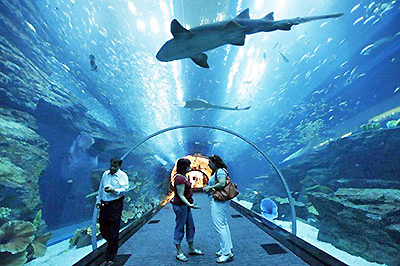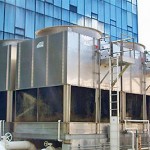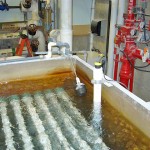Life science exhibits house living aquatic species for public viewing at aquariums, marine parks, zoos and hotels. Regardless of the animal type, the provision and maintenance of clean water is a critical requirement. Within the life science market, there are three main application segments including the pre-treatment of water prior to being introduced to the exhibit, the monitoring of the exhibit itself, and the post-treatment of wastewater after its been removed from the exhibit. Exhibit tanks range widely in depth and capacity based upon the species, their environmental requirements and associated display scenery such as rocks, plants, water features and backdrops. The support equipment is typically located behind the exhibit or hidden within the scenery. To maintain water quality and make up for evaporation, water is continuously circulated in and out of the exhibit. The primary requirement for this application is to monitor the liquid level, maintain it, and prevent it from rising or falling to levels that would endanger the inhabitants.
Technology
A short duration, high frequency ultrasonic sound wave is pulsed up to four times per second from the face of the transducer. The sound wave reflects off the surface of the liquid and returns to the transducer. The level sensor measures the time of flight between the sound generation and receipt, and translates this into the distance between the transducer face and liquid surface. The distance is then converted into a percentage of measured span and output as a proportional 4-20 mA signal.
Best Practices
The installed level sensor must have a clear view of the liquid surface. This means that the measurement space beneath the level sensor should be free of any obstructions such as pipes, fittings, ladders, walls, animals, plants or debris within the exhibit. The level sensor must be located above the highest liquid level and never be submersed during normal operation. Exhibits can be indoors or outdoors, which depending upon the level sensor’s location and type of installation, may result in the formation of water droplets or ice on the transducer that can affect acoustic transmission and receipt. Where so, select a level sensor with an appropriate weatherproof enclosure rating and longer more powerful measurement range. Apply a very thin layer of Rain-X or petroleum jelly water repellant across the transducer face and locate the level sensor so it’s not directly exposed to weather. Some exhibits may have substantial agitation, either generated by the exhibit systems or animals in them. Where so, the level sensor should be installed in a stand-pipe to dampen the agitation from the point of measurement, and care must be taken to ensure that plant or animal life cannot enter and clog the stand-pipe.
Installation
There are several ways to mount a level sensor in this application. Locate the level sensor out of public view and away from large species or processes that could negatively affect the level sensor. Find a mounting location where the level sensor has a direct view of the liquid throughout the entire measurement span. The location must be flat, level to the liquid and accessible. The following equipment can be used to install the sensor.
Stand-Pipe
Level sensors can be installed in a stand-pipe to separate surface foam, dampen turbulence or maximize the acoustic signal strength of the level sensor. Do not use a stand-pipe in applications with dirty, coating or scaling liquids that will leave material build-up on the inner pipe wall. The stand-pipe must be one continuous section of smooth pipe without any breaks or transitions. The pipe’s inner diameter must be equal to or greater than the level sensors beam width and larger diameter pipes are recommended. To install the level sensor, mount a low-profile threaded coupling on top of the pipe. Just under the coupling, and within the level sensors dead band, drill two quarter inch vent holes on opposing sides of the pipe. The pipe should extend to the bottom of the tank, or at least below the level sensor’s measurement span. Cut a 45º angle on the bottom of the pipe. Finally, the level should be maintained above the 45º cut, so there’s always liquid in the pipe.
Side Mount Bracket
The Flowline side mount bracket can be used to install the level sensor against the side wall of the exhibit or an aperture extended over the exhibit.
Tank Adapter
Tank adapters are recommended where the mounting location is level and not on a slope. Use a tank adapter that is slip x thread, and avoid thread x thread adapters. Do not use tank adapters that are mounted upside down.
Coupling
A shorter half coupling is preferred over a taller full coupling. Use a coupling that is slip x thread, and avoid thread x thread couplings. If you use a full coupling, it must follow the height and diameter restrictions described under Riser with Flange.
Electrical
Exhibits may be located near large pumps, motors or variable frequency drives that can generate substantial EMI or RFI noise. Make sure that such devices are grounded to earth, and then ground the level sensor and associated electrical equipment to the same earth-ground as these devices. Some areas maybe subject to frequent lightning strikes or have un-reliable power. Where so, proper surge protection and filtering is recommended.
Span
The level sensor outputs a 4-20 mA current signal that’s proportionate to the measurement span within the exhibit. Users typically set the 4 mA to empty or the lowest measured level, and 20 mA to full or the highest measured level. Avoid placing the 4mA or 20mA span set points at or near levels where pumps, valves or alarms may actuate.
Interface
The level sensors 4-20 mA current signal is normally connected to a local controller or centralized control system. These devices may include a PLC, SCADA, DSC or stand-alone level controller. Either control device is fine as long as it accepts a 4-20 mA current signal. The operational range of the controller must then be programmed to match the measurement span of the level sensor, and take into account that the sensors 4 mA set point is normally placed above the empty tank condition. Remember, the primary requirement for this application is to monitor the liquid level, maintain it, and prevent it from rising or falling to levels that would endanger the inhabitants. Once the controllers operational range has been configured to the correct levels and engineering units, then the relay set points are applied for pump, valve or alarm automation. An independent high and low level alarm or safety shut off system should always be used in addition to the primary system.








